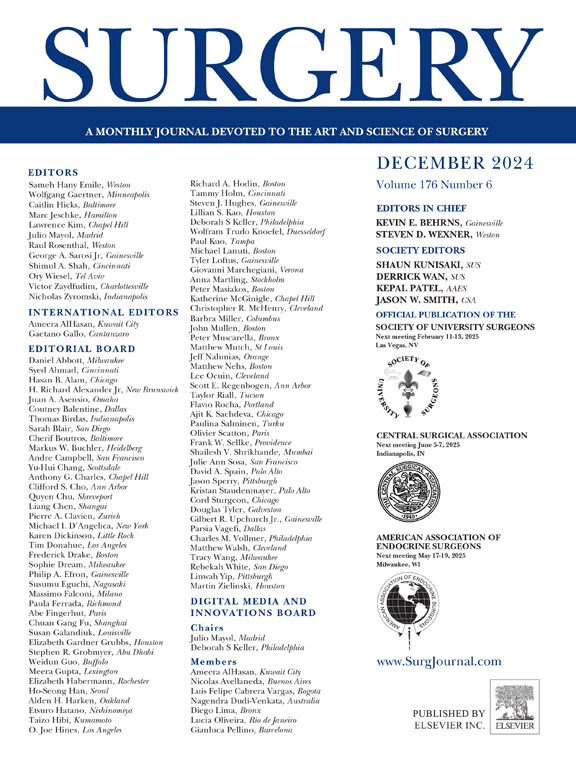The effect of surgical management in mitigating fragility fracture risk among individuals with primary hyperparathyroidism
IF 3.2
2区 医学
Q1 SURGERY
引用次数: 0
Abstract
Background
Primary hyperparathyroidism predominately affects women who are postmenopausal and causes complications, including fragility fractures. Its treatment is parathyroidectomy, which is associated with low complication and >95% cure rates. Considering fractures are associated with premature death, we aimed to determine whether the surgical management of individuals with biochemical diagnosis of primary hyperparathyroidism was associated with a reduction in fracture risk.
Methods
In this population-based cohort study, we used administrative health databases to identify adults ≥18 year old who were biochemically diagnosed with primary hyperparathyroidism between 2007 and 2016 in Ontario. Patients were included if their calcium was ≥2.6 mmol/L (≥10.42 mg/dL) with a concurrent parathyroid hormone of ≥2.2 pmol/L (≥20.75 pg/mL). We followed patients and compared the incidence of fractures between those with and without parathyroidectomy. To control for potential confounding, we used inverse probability of treatment weighting to estimate the average treatment effect in the treated. Fine-Gray competing risk regression models were used to determine the association between surgery and time to fracture.
Results
In a cohort of 28,059 with a biochemical diagnosis of primary hyperparathyroidism, the mean age (standard deviation) was 65 years (14.2 years), and 75% (n = 21,139) were female. Only 12.6% (n = 3,523) underwent parathyroidectomy. Weighted fracture cumulative incidence at 12 years postdiagnosis was 10.17% (n = 182) in surgical patients and 14.04% (n = 2,004) in nonsurgical patients. Parathyroidectomy prevented 1 fracture for every 26 surgeries performed (weighted risk difference, 3.87%, 95% confidence interval, 0.96%–6.62%) and reduced the hazard of fracture by 22% (weighted hazard ratio, 0.78; 95% confidence interval, 0.64–0.95).
Conclusion
In a large, publicly funded health system, parathyroidectomy significantly reduced the short- and long-term risk of fragility fractures in patients with primary hyperparathyroidism.
手术治疗在降低原发性甲状旁腺功能亢进症患者脆性骨折风险方面的效果。
背景:原发性甲状旁腺功能亢进症主要影响绝经后的妇女,并导致包括脆性骨折在内的并发症。其治疗方法是甲状旁腺切除术,并发症少,治愈率>95%。考虑到骨折与过早死亡有关,我们旨在确定对生化诊断为原发性甲状旁腺功能亢进的患者进行手术治疗是否与降低骨折风险有关:在这项基于人群的队列研究中,我们使用行政健康数据库来识别安大略省在 2007 年至 2016 年间被生化诊断为原发性甲状旁腺功能亢进症的年龄≥18 岁的成年人。如果患者的血钙≥2.6 mmol/L(≥10.42 mg/dL),同时甲状旁腺激素≥2.2 pmol/L(≥20.75 pg/mL),则将其纳入研究。我们对患者进行了随访,并比较了进行和未进行甲状旁腺切除术的患者的骨折发生率。为了控制潜在的混杂因素,我们采用了反概率治疗加权法来估算治疗者的平均治疗效果。精细格雷竞争风险回归模型用于确定手术与骨折发生时间之间的关系:在生化诊断为原发性甲状旁腺功能亢进的28059名患者中,平均年龄(标准差)为65岁(14.2岁),75%(n=21139)为女性。只有12.6%(3523人)接受了甲状旁腺切除术。手术患者在确诊后12年的加权骨折累积发生率为10.17%(n = 182),非手术患者为14.04%(n = 2,004)。每进行26例手术,甲状旁腺切除术可预防1例骨折(加权风险差异为3.87%,95%置信区间为0.96%-6.62%),骨折风险降低22%(加权风险比为0.78;95%置信区间为0.64-0.95):结论:在大型公立医疗系统中,甲状旁腺切除术可显著降低原发性甲状旁腺功能亢进症患者短期和长期脆性骨折的风险。
本文章由计算机程序翻译,如有差异,请以英文原文为准。
求助全文
约1分钟内获得全文
求助全文
来源期刊

Surgery
医学-外科
CiteScore
5.40
自引率
5.30%
发文量
687
审稿时长
64 days
期刊介绍:
For 66 years, Surgery has published practical, authoritative information about procedures, clinical advances, and major trends shaping general surgery. Each issue features original scientific contributions and clinical reports. Peer-reviewed articles cover topics in oncology, trauma, gastrointestinal, vascular, and transplantation surgery. The journal also publishes papers from the meetings of its sponsoring societies, the Society of University Surgeons, the Central Surgical Association, and the American Association of Endocrine Surgeons.
 求助内容:
求助内容: 应助结果提醒方式:
应助结果提醒方式:


